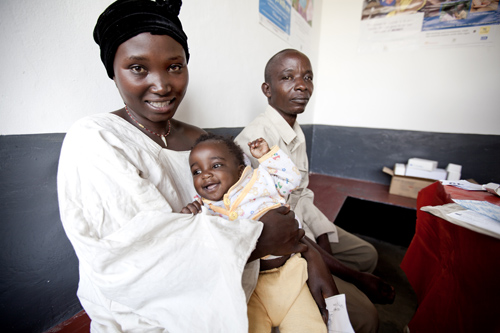Cross-posted from Elizabeth Glaser Pediatric AIDS Foundation Blog
Posted by Dr. Serge Agbo, MPH
Abidjan, Côte d’Ivoire
March 21, 2012
Too many people around the world have forgotten about the dangers of tuberculosis, also known as TB.
TB is a highly contagious bacterial infection that can be spread in saliva, most often through coughing, sneezing, or exhaling in close quarters.
While TB has a lower profile today, an estimated one-third of the world’s population is infected – and in sub-Saharan Africa, that infection is often paired with HIV.
World TB Day is intended to raise awareness about the dangers of tuberculosis, and the steps governments, organizations, and individuals are taking to combat it.
As we mark the 30th World TB Day on March 24th, we remember that tuberculosis remains a danger for millions around the world: it is the second-leading cause of death from an infectious disease worldwide, and the third-leading cause of death for women overall.

A family waits to be tested for HIV at the Kitwe Health Clinic IV in Ntungamo district in Uganda.
(Photo: James Pursey/EGPAF)
For most people, TB stays dormant in their bodies and causes relatively few problems. But for the elderly or people with compromised immune systems, active TB can be extremely dangerous – causing fever, weight loss, clubbing of the fingers and toes, and breathing problems.
If not treated in time, up to two-thirds of those with active TB die from the disease.
Those living with HIV are among the most susceptible to TB. Of the 15 countries with the highest incidence of TB, 13 are in Africa –ndash; and those countries exhibit a high HIV co-infection rate. In South Africa, for example, up to 60% of those with TB also have HIV.
HIV-positive pregnant women are ten times more likely to contract TB, and those with TB have a greater likelihood of passing HIV on to their infants through mother-to-child transmission. TB infection also leads to a much higher mortality rate for both mothers and babies.
For children, TB is a largely overlooked and neglected issue. Early detection and diagnosis of TB in children remains a challenge, particularly for HIV-positive children. They often have other pulmonary conditions and HIV-related chronic lung diseases that mimic the symptoms of TB.
Children living with HIV have a higher risk of dying of TB because their immune systems are weaker, and treatment options are more limited. Medicines to treat TB in children lag behind the treatment options available to adults, and are often difficult to administer to young children.
The good news is that TB is preventable and treatable, and treating HIV and TB together can be highly successful.
The WHO TB treatment guidelines point to combining TB treatments and antiretroviral therapy (ART) as an effective way to limit TB incidence by up to 90% in individuals.
The risk of TB among children and HIV-positive women could be greatly reduced by improving integration of TB services within existing programs to prevent mother-to-child transmission (PMTCT) of HIV, as well as within broader maternal and child health (MCH) services.
Increasing screenings of HIV-positive pregnant women for TB and expanding TB testing to child immunization programs could help address HIV and TB co-infection in mothers and children. New testing equipment could also significantly reduce the amount of time it takes to get TB test results back, and increase the accuracy of those results – while also detecting more dangerous drug-resistant TB.
It is also important to trace contact and potential TB exposure among households to ensure that the whole family is diagnosed and treated.
The Foundation is taking a leading role in developing frameworks to prevent and treat HIV and TB.

The line of people waiting to visit the Kitwe Health Clinic IV in Ntungamo district in Uganda.
(Photo: James Pursey/EGPAF)
In Uganda, where 54% of TB cases occur in people living with HIV, the Foundation supports rural health facilities that provide both TB treatment and HIV care through our STAR-SW project. This program prioritizes active case finding for TB beginning with specific populations, such as HIV-positive pregnant women attending antenatal clinics (ANC).
In many other countries, the Foundation has helped to develop and support a “one-stop” service model to screen for TB and HIV, particularly in maternal and child health settings and ANC clinics.
In addition, our 2007 International Leadership Awardee, Dr. Anneke Hesseling, has focused her research on TB and mothers and children in South Africa, which has the second highest rate of TB infection worldwide.
Supported by Jewelers for Children, her work has quickly led to changes in clinical practices, such as better tracking of potential TB cases in children in South African clinics and revised WHO policy about when is best to vaccinate HIV-exposed infants for TB.
Because maternal TB is associated with increased mother-to-child transmission of HIV, preventing TB among HIV-infected mothers and children must be a top priority for HIV programs in communities with a significant TB/HIV burden.
In our mission to create a healthy and thriving HIV-free generation, we must ensure that we do everything in our power to also keep that generation TB-free.
Dr. Serge Agbo is the Foundation’s Technical Officer on TB/HIV integration, based in Côte d’Ivoire.
For more information from the WHO on the neglected issue of children and TB, click here

